It will be little more than a year since the movement against the El Khomri law started. What has this massive mobilisation represented in the current period?
First of all, it should be noted that this mobilisation came at the end of Hollande’s mandate, a year before the elections. Despite the many anti-social attacks of the PS government, no mass mobilisation of the working class had succeeded in starting off before this one: ANI, responsibility pact, the Macron law … We had never gone beyond the stage of the famous “day of action”, whether clearly limited strikes or one-day events. It is important to note that until the movement against this Labour Law, the only “massive” mobilisation was the reactionary mobilisation against marriage for all in the middle of this decade. This mobilisation against the Labour Law was therefore surprised by the scale and speed at which it developed in a context where everything seemed unfavorable (state of emergency following the attack of November 13th 2015, elections next year…).
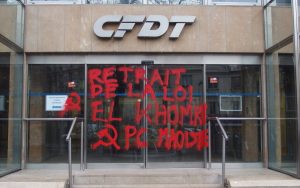
Although the first demonstration had taken place on March 9th, 2016, the association of unions initially scheduled the first demonstration for March 31st … more than a month after media coverage of the plan for the law, and did not immediately demand complete withdrawal of the law! Only because the popular base of the union put pressure on the union leaders were they forced to follow the grassroots demands. Thus from the beginning, this divison between union leadership and the unionised base surfaced.
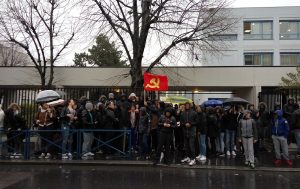 It was during this first period of the movement from March 9th to March 31st that the youth of the working-class districts were active through blockades of their high schools, high school demonstrations and the determined participation of workers. Even in the face of repression, they did not put their heads down with the attack on two police stations in Paris, in response to the blow to the head of the young Adam by a cop who made the rounds online. However the spring school break quickly slowed down this dynamic. Though the youth of working-class districts had mobilised, the union leaders did not try to include young people in the movement. Without idealising the youth, it is necessary in a social movement to optimise and coordinate all the forces at play, and if the union leaders had included youth in the movement rather than looking at them with suspicion, sometimes even confronting them with their security people, they could have been an important force for the movement, and it could even have allowed the protest to gain a foothold in areas where workers live; working-class neighborhoods.
It was during this first period of the movement from March 9th to March 31st that the youth of the working-class districts were active through blockades of their high schools, high school demonstrations and the determined participation of workers. Even in the face of repression, they did not put their heads down with the attack on two police stations in Paris, in response to the blow to the head of the young Adam by a cop who made the rounds online. However the spring school break quickly slowed down this dynamic. Though the youth of working-class districts had mobilised, the union leaders did not try to include young people in the movement. Without idealising the youth, it is necessary in a social movement to optimise and coordinate all the forces at play, and if the union leaders had included youth in the movement rather than looking at them with suspicion, sometimes even confronting them with their security people, they could have been an important force for the movement, and it could even have allowed the protest to gain a foothold in areas where workers live; working-class neighborhoods.
It took three months of demonstrations for the union leaders (CGT, SUD) to call for an indefinite strike. The strategy of doing only one-day strikes accompanied by peaceful demonstrations does not enable a sufficient balance of power; on the contrary, it has shown a certain inability to pressure the bourgeois state. This has affected the movement by leaving the field free to the government, which was allowed to use 49-3 [This clause of the French constitution allows the government to impose the adoption of a text by the assembly, immediately and without a vote, that the assembly cannot oppose without toppling the government through a motion of no confidence.] three times without without a worry. Meanwhile, the General Secretary of the CGT changed the command of total withdrawal to “withdrawl of the spine of the project”. The call to strike for the last month before the summer holidays sounded like the last card these unions could play. Large sectors like refineries or nuclear power plants went on strike, but the state and its police were able to put an end to the strikes and the blockades very quickly, with ultimately very little resistance: due to lack of expansion, these strikes and blockades that were able to last up to three weeks were insufficient.
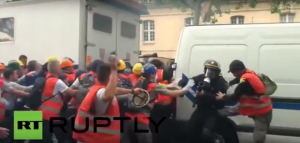 A major national demonstration had been called by the unions on June 14th. There were over a million demonstrators, the mobilisation was very dynamic and combative, in reaction the state responded with heavy repression causing hundreds of wounded, 58 arrested in Paris alone, and water cannons were used for the first time since the beginning of the movement in Paris. The following day, Valls suggested banning the upcoming demonstrations called for by the CGT. A prohibited CGT demonstration had not been done since the war in Algeria, when a ban on demonstrations was faced fearlessly and which ended with the Charonne massacre. This set the tone. And while the next demonstration was held but over a ridiculously short route, no less than 95 people were arrested before entering the demonstration. The mere possession of scarves or glasses could be used as a pretext for the police. A special police force was organised with more than 2,000 cops scattered around the meeting point, meaning most people were searched at least two or three times before they could join the demonstration. It was mostly the same for the last two demonstrations in Paris.
A major national demonstration had been called by the unions on June 14th. There were over a million demonstrators, the mobilisation was very dynamic and combative, in reaction the state responded with heavy repression causing hundreds of wounded, 58 arrested in Paris alone, and water cannons were used for the first time since the beginning of the movement in Paris. The following day, Valls suggested banning the upcoming demonstrations called for by the CGT. A prohibited CGT demonstration had not been done since the war in Algeria, when a ban on demonstrations was faced fearlessly and which ended with the Charonne massacre. This set the tone. And while the next demonstration was held but over a ridiculously short route, no less than 95 people were arrested before entering the demonstration. The mere possession of scarves or glasses could be used as a pretext for the police. A special police force was organised with more than 2,000 cops scattered around the meeting point, meaning most people were searched at least two or three times before they could join the demonstration. It was mostly the same for the last two demonstrations in Paris.
This repression is supposed to be the cause of the behavior of “casseurs” (vandals)? If the union leaders are all reformists (with differences of course, the yellow CFDT union is not the CGT) and hold back the struggle as we have seen, militants who focus solely on violence are also detrimental. It is not at a demonstration that an insurrection will occur spontaneously. Violence against targets recognised as enemies by the masses is certainly an essential element in spreading the idea that we should not stay within the legal framework to obtain victories and to habituate the masses to confrontation. But violence must always take place in connection with the masses, for it is the masses who make revolution. At first, the idea to use popular culture to make slogans in order to attract young people from working-class neighborhoods was good, but slogans alone cannot attract in the long run and organise something. Alongside the confrontation, there is prolonged political work to be done with the masses in terms of conscientisation of revolutionary ideas and organisation.
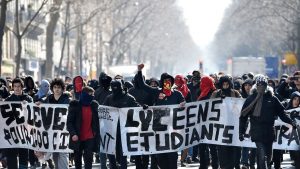 Let it be made clear that it is the basis of every authentic Communist Party to recognise and apply the principle of revolutionary violence. Since our inception and throughout the struggle against the Labour Law, we have ceaselessly repeated it and show it through our practice. But violence alone is not enough. Without a protracted struggle, without the development of sustainable frameworks of struggle, without striving to forge ever closer and deeper bonds among the masses, nothing will change and the only developments that we could observe will be quantitative and not qualitative: without a concrete revolutionary strategy, the biggest “lead group” will never change anything. Having said that, we must nevertheless reaffirm the positive aspect of the violence that was expressed during this struggle. This movement frightened the bourgeoisie because it carried within it a militancy not seen for a long time. We must also see the recent blockades of high schools against police violence as an extremely positive legacy of the fight against the Labor Law.
Let it be made clear that it is the basis of every authentic Communist Party to recognise and apply the principle of revolutionary violence. Since our inception and throughout the struggle against the Labour Law, we have ceaselessly repeated it and show it through our practice. But violence alone is not enough. Without a protracted struggle, without the development of sustainable frameworks of struggle, without striving to forge ever closer and deeper bonds among the masses, nothing will change and the only developments that we could observe will be quantitative and not qualitative: without a concrete revolutionary strategy, the biggest “lead group” will never change anything. Having said that, we must nevertheless reaffirm the positive aspect of the violence that was expressed during this struggle. This movement frightened the bourgeoisie because it carried within it a militancy not seen for a long time. We must also see the recent blockades of high schools against police violence as an extremely positive legacy of the fight against the Labor Law.
Where a lot has happened, and maybe even more than in the lead groups, is in the blockades. Experiences were very diverse. The most interesting are those in which unity at the grass-roots level was realised, that is to say where locally, in their diversity of experiences regarding struggle and political horizons, the masses united around a certain nucleus to give a radical expression to the movement. The blockades were the expression of the strength of the working class: everything runs thanks the force of our labour and we can demonstrate it. The blockades were mainly significant in the regions [administrative divisions of France], there were relatively few in the Paris region. In the blockades, we saw positions evolve, illusions fall and solidarity develop, mainly in the face of repression. Several hundred strikers launched into the Internationale in front of a court judging an imprisoned comrade, it may be symbolic for some but it means a lot for those present (especially for the comrade being persecuted!). Unity at the base was thus realised in this movement, though still too partially, but it was a lesson of struggle for all those who were involved and were able to live it.
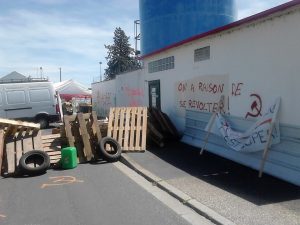 This struggle had the characteristic of being a “semi-defeat” in the sense that on the one hand the law was not repealed, but on the other hand it is not suppression that finally marked the struggle (as it may have been the case after the struggle for pensions in 2010…) but rather a renewed energy, newly created connections, and a greater solidarity for the revolutionary wing of the movement which enabled, for example, the call for blockades of high schools for Théo via social media, or the spread of the idea of boycotting the presidential elections, an idea shared by a large number of workers who have denounced politicians’ attempts to save face during the movement and which is now being realised for instance by the call of many trade unionists for a “1st social round” to take the streets against the elections. The idea of resistance and the possibility of direct confrontation with the state has developed, despite severe repression. It should also be noted that this movement has allowed a break with the climate of rising fascism by counteracting the usual persistence of the media about Muslims, immigration, banlieues, etc.
This struggle had the characteristic of being a “semi-defeat” in the sense that on the one hand the law was not repealed, but on the other hand it is not suppression that finally marked the struggle (as it may have been the case after the struggle for pensions in 2010…) but rather a renewed energy, newly created connections, and a greater solidarity for the revolutionary wing of the movement which enabled, for example, the call for blockades of high schools for Théo via social media, or the spread of the idea of boycotting the presidential elections, an idea shared by a large number of workers who have denounced politicians’ attempts to save face during the movement and which is now being realised for instance by the call of many trade unionists for a “1st social round” to take the streets against the elections. The idea of resistance and the possibility of direct confrontation with the state has developed, despite severe repression. It should also be noted that this movement has allowed a break with the climate of rising fascism by counteracting the usual persistence of the media about Muslims, immigration, banlieues, etc.
The contradiction between the proletariat and the bourgeoisie in the French state is becoming more and more acute. The movement against the Labor Law took place in a particular framework, which was that of a “socialist” government, which put into effect an unofficially permanent state of emergency. A framework in which the rise of fascism was such that for the presidential election of 2017, the coming to power of Marine Le Pen appears possible, in which the police apparatus has ceaselessly reinforced and continues to reinforce itself by transforming for example the legitimate defense of the police into a license to kill, in which three revolts took place in less than a year in reaction to the murder of Shaoyo Liu, Adama and the police rape of Théo, in which measures that are clearly part of the rise of fascism have been taken such as the creation of a national file regrouping the data of all citizens or a decree of the government that provokes the indignation of the highest French jurisdiction itself regarding its independence, in which the bloody war of plunder of the French state continues in Syria and in which the repression of migrants is strengthened. As communists and revolutionaries, we must assume our responsibilities by working to closely connect to the masses, by creating combative organisations for the masses and the working class in order to establish a solid anti-fascist front, to make the resistance of workers more effective, to allow new social gains and to prepare the ground for the overthrow of the bourgeois state and for the establishment of proletarian power.
Long live the struggle of the workers!
Let’s start from the positive and go beyond the negative for victory!
All power to the working class!
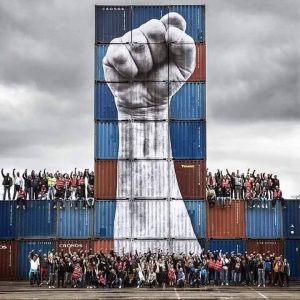
Source: http://www.pcmaoiste.org/communique/un-an-apres-retour-sur-le-mouvement-contre-la-loi-travail/
